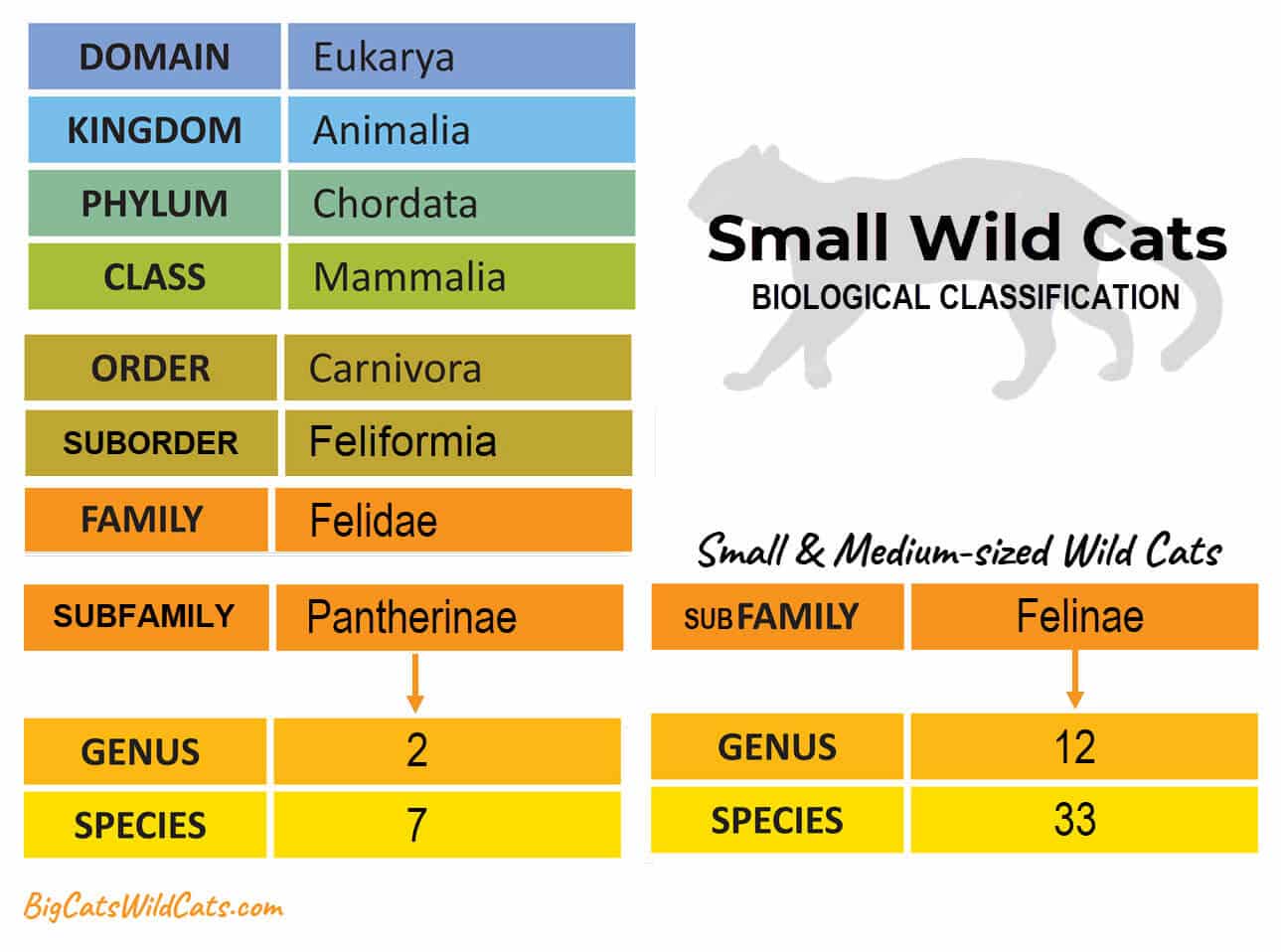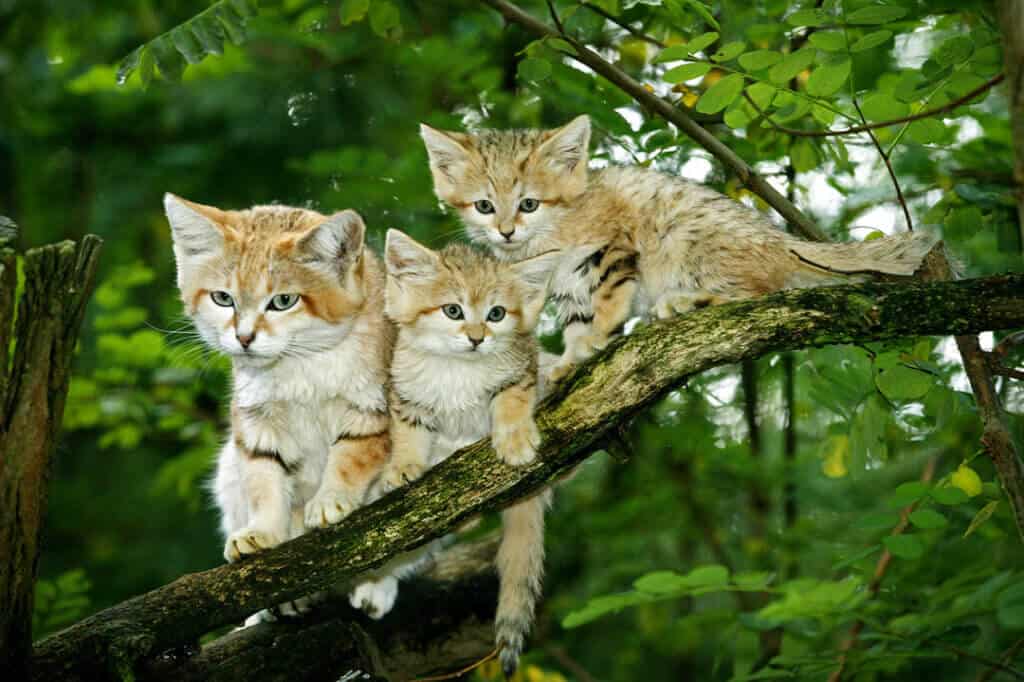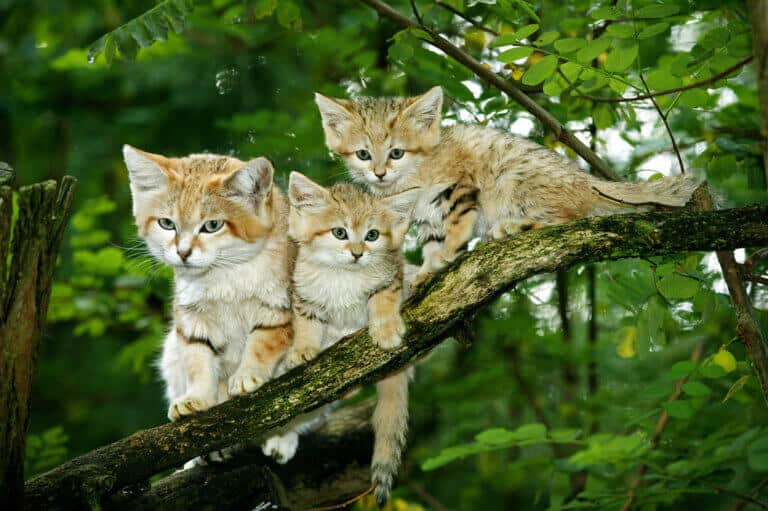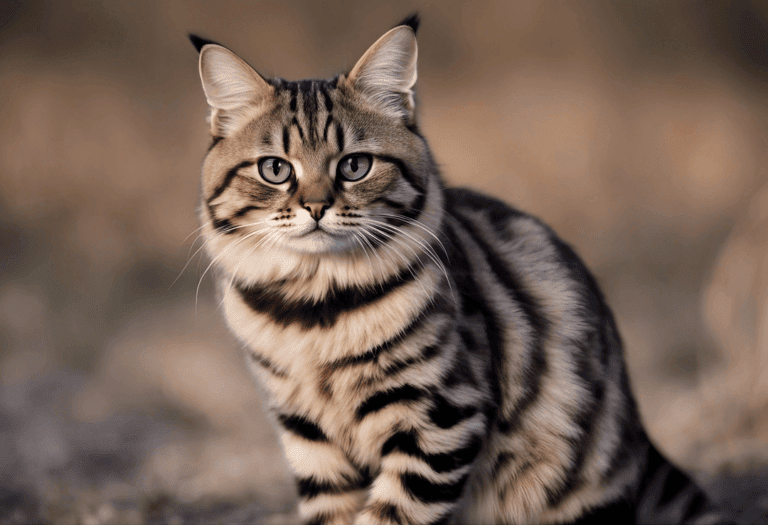Small wild cat biological classification is a way of grouping cats with similar characteristics. It also shows how the cats are related to each other. Even though today’s classification system has been around since the 1700s, there are still many different opinions when it comes to how wild cats should be classified.
Classifying small wild cats
Big and small wild cats are classified as members of the Carnivora (meat-eaters) order, Feliformia suborder, and Felidae family. It is believed the Felidae diverged (separated) from the Feliformia suborder between 25 and 35 million years ago, and the Felinae and Pantherinae split around 11.5 million years ago.
The Pantherinae subfamily includes big cats like the lion, tiger, jaguar, leopard, and snow leopard. Two medium-sized cats, the clouded and the Sunda clouded leopard, also belong to the Pantherinae subfamily.
The remaining medium-sized and small wild cats are members of the Felinae subfamily.
According to various researchers, the first cats—the Proailurus and Pseudaelurus—appeared around 25 million years ago.
The Proailurus inhabited Europe and Asia between 25 and 30 million years ago. It was somewhat bigger than the domestic cat. Physical characteristics included a long tail, big eyes, sharp teeth and claws, and a weight of around 20 lbs.
The Pseudaelurus, which was the size of a cougar, lived in Asia, North America, and Europe between 8 and 20 million years ago. It was the first cat to appear in North America around 18.5 million years ago. There were various Pseudaelurus species.
Migration
The history of modern cats began long ago in Asia with a common ancestor (Pseudaelurus). Eventually, the cats migrated to other parts of the world. The migrations occurred during various ice ages when sea levels declined, and land bridges appeared connecting different continents. The drop in sea levels was due to the large amount of seawater that evaporated and turned into snow and ice.
One of the most famous land bridges was the Bering land bridge. It existed 20,000 years ago, and connected eastern Russia to Alaska.
Common Felidae characteristics
Both big cats and small wild cats have many similar characteristics, including:
- Five toes on their front feet and four on their back feet.
- Pads on both front and back feet that act like cushions
- Flexible and muscular bodies
- 30 teeth
- Tongues covered with tiny bumps that give it a rough texture
- Noses that extend beyond the jaw
- Relatively large eyes with binocular vision (two eyes facing the same direction) and excellent night vision
- Stiff hair (whiskers) on the cheeks, above the muzzle and eyes
- Large, sensitive ears
- A sense organ in the roof (soft tissue) of their mouth that allows them to detect chemicals (taste the air).
The cats of the Felinae subfamily
The Felinae subfamily is made up of 12 genera. A genus ranks above species and below family. It is a class of living things that have common characteristics. The twelve genera of the Felinae subfamily are:
- Pardofelis
- Catopuma
- Leopardus
- Leptailurus
- Caracal
- Lynx
- Acinonyx
- Herpailurus
- Puma
- Otocolobus
- Prionailurus
- Felis
There are one or more species of cat in each genus.
The smallest wild cats are the sand cat, rusty-spotted cat and black footed cat. The rusty-spotted cat is a member of the Prionailurus genus. It is 14 to 19 inches long and weighs between 2 and 3.5 lbs. The black-footed cat is a member of the Felis genus. It is 14 to 17 inches long and weighs up to 5.4 lbs. The sand cat is 15 to 20 inches long and weighs 3.3 to 7.5 lbs.
The eight wild cat lineages
Following new DNA research conducted in 2006, and the use of other essential research tools, the various Felidae species were divided into eight lineages. Each group came from a common ancestor and shared similar morphological (form and structure), biological and physiological characteristics.
Here is a list of the eight lineages:
- Panthera
- Caracal
- Ocelot
- Bay cat
- Lynx
- Puma
- Leopard cat
- Domestic cat
Members of the Panthera lineage include the four big cats that roar (tiger, lion, leopard and jaguar) and the Sunda clouded leopard and clouded leopard.
The remaining lineages are made up of medium-sized and small wild cats.
The first three lineages to appear were the Panthera lineage, Bay cat lineage and Caracal lineage.
Lineages with small and medium-sized cats
Seven of the eight wild cat lineages include small and medium-sized cats.
Bay cat lineage
Genus: Pardofelis, Catopuma
Species: Marbled cat (Pardofelis), the Borneo bay cat and Asian golden cat (Catopuma)
The Bay cat lineage includes two species of small wild cats, the marbled cat and bay cat, and a medium-sized cat, the Asian golden cat. The lineage appeared between 7.5 and 9.4 million years ago. All three cats evolved in southeast Asia.
Caracal lineage
Genus: Leptailurus, Caracal
Species: Serval, African golden cat, caracal
Ocelot lineage
Genus: Leopardus
Species: Andean mountain cat, ocelot, margay, pampas cat, oncilla – southern tiger, oncilla – northern tiger cat, Geoffroy’s cat, kodkod
Eight small wild cats inhabit Central and South America, including the Andean mountain cat, ocelot, margay, pampas cat, oncilla, Geoffroy’s cat, and kodkod.
Ocelot lineage ancestors first appeared in North America around 8 million years ago. They migrated over the Panama land bridge to South America, evolving into several species.
Lynx lineage
Genus: Lynx
Species: Bobcat, Canada lynx, Eurasian lynx and Iberian lynx.
The lynx lineage includes four medium-sized wild cats: the bobcat, Canada lynx, Eurasian lynx, and Iberian lynx. The lineage appeared around 7.2 million years ago and evolved in Europe and Africa. The Eurasian lynx is the largest of the four lynx species.
Puma lineage
Genus: Acinonyx, Herpailurus, Puma.
Species: Cheetah, jaguarundi, cougar
The Puma Lineage includes two of the biggest cats on the planet, the cheetah and cougar, along with the medium-sized jaguarundi. Members of the Puma Lineage appeared in North America approximately 6.7 million years ago. The puma remained in the Americas, the cheetah migrated to Eurasia and Africa, and the jaguarundi migrated to Mexico, Central, and South America.
Leopard cat lineage
Genus: Otocolbus, Prionailurus
Species: Pallas’s cat, rusty-spotted cat, flat-headed cat, leopard cat, Sunda leopard cat, fishing cat
Members of the Leopard cat lineage are Asian wild cats. They include one species from the genus Otocolobus (Pallas’s cat) and five species from the genus Prionailurus. The fishing cat is a medium-sized wild cat. The lineage appeared approximately 6.2 million years ago when ancestors migrated back from North America to Asia.
Domestic cat lineage
Genus: Felis
Species: Jungle cat, black-footed cat, sand cat, Chinese mountain cat, African wildcat, European wildcat, domestic cat
Location: Felis wild cats inhabit Africa, Europe, Asia, and Indochina, while domestic cats can be found worldwide.
Members of the Felis genus are small and medium-sized cats. The Felis genus diverged from the Felidae between 1 and 3 million years ago.
More about small wild cats:





0 Comments